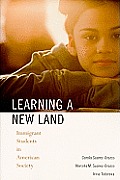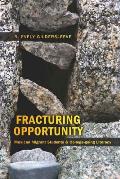- About
- Programs
- Issues
- Academic Freedom
- Political Attacks on Higher Education
- Resources on Collective Bargaining
- Shared Governance
- Campus Protests
- Faculty Compensation
- Racial Justice
- Diversity in Higher Ed
- Financial Crisis
- Privatization and OPMs
- Contingent Faculty Positions
- Tenure
- Workplace Issues
- Gender and Sexuality in Higher Ed
- Targeted Harassment
- Intellectual Property & Copyright
- Civility
- The Family and Medical Leave Act
- Pregnancy in the Academy
- Publications
- Data
- News
- Membership
- Chapters
May-June 2012: The Price of Philanthropy
Beyond the Vitriol
Learning a New Land: Immigrant Students in American Society. Carola Suárez-Orozco, Marcelo Suárez-Orozco, and Irina Todorova. Cambridge, MA: Harvard University Press, 2008.
Fracturing Opportunity: Mexican Migrant Students and College-Going Literacy. R. Evely Gildersleeve. New York: Peter Lang, 2010.
|
Learning a New Land
 by Carola Suarez-Orozco and Marcelo M. Suarez-Orozco and Irina TodorovaTrade Paperback by Carola Suarez-Orozco and Marcelo M. Suarez-Orozco and Irina TodorovaTrade Paperback |
According to Carola Suárez-Orozco, Marcelo Suárez-Orozco, and Irina Todorova’s book Learning a New Land: Immigrant Students in American Society, which was recently reissued in a paperback edition, one in five children in the United States today is a child of immigrants. By 2040, children of immigrants are expected to make up one-third of all US children. As immigrants and children of immigrants increase in numbers, virulent anti-immigrant discourse and policies are on the rise, and immigrant voices are often lost in the hubbub. How can educators better serve these students in the current historical, social, economic, and political environment?
Learning a New Land and another recent ethnographic book, R. Evely Gildersleeve’s Fracturing Opportunity: Mexican Migrant Students and College-Going Literacy, provide important insights into how (im)migrant students—that is, immigrant and migrant students—perceive and navigate the US educational system. (For the purposes of this review, immigrant students are defined as students who have moved from outside of the country into the United States at some point in their lives, while migrant students are defined as students from families that move around either within the United States or between the United States and other countries to pursue seasonal employment opportunities.)
The authors of Learning a New Land conducted a five-year longitudinal ethnographic study following the educational trajectories of 309 Mexican, Central American, Dominican, Haitian, and Chinese immigrant students in Boston and San Francisco. These students were of mixed ages, and all were enrolled in the public K–12 school system at the beginning of the study. The authors chose these particular racial and ethnic groups because Mexican and Chinese immigrants constitute the largest immigrant groups, Central American immigrants encounter distinctive political and economic issues in their immigration, and Dominican and Haitian immigrants are understudied. Ethnographic data used in the study included interviews with students, families, and teachers as well as in-school observations. In addition, the authors assessed students’ academic skills and obtained achievement data from schools in order to examine the relationship between immigrant children’s educational experiences and their academic achievement.
The book addresses a long-standing gap in the research literature about the critical role of the K–12 context in immigrant groups’ academic achievement. Many immigrant students attend schools that have far fewer resources than other public schools. The climate in some of these schools does not promote optimal learning. The students tend to encounter high degrees of violence and racial tension; some of the schools are among the most violent in the country. Students describe teachers who are often disengaged or unhelpful to them. Some teachers in the study express lower expectations of Latino students than of Asian American students, and these assumptions affect how different immigrant students learn.
Many students fall short of their academic potential because their progress (or lack of it) is not carefully monitored. Little, if any, college guidance is available in most of the schools they attend, in part because counselors often have caseloads that are too high—up to 809 students per counselor in California, according to a 2010 report from the National Association for College Admissions Counselors. Many counselors at these schools have limited time to help students and are not knowledgeable about suitable college options. Unfortunately, the lack of guidance counseling is especially harmful to immigrant students, most of whom come from families with no US college experience. One of the book’s cautionary tales is the story of a gifted student who is qualified for a highly selective institution but, because he does not receive encouragement or informed guidance, instead attends a far less selective college.
Gildersleeve’s ethnographic study shows just how important encouragement and guidance are. His book explores how twelve migrant students participating in a university outreach program, the Migrant Student Leadership Institute (MSLI) at the University of California, Los Angeles, navigate the process of going to college. Using a sociocultural approach, he frames this process as learning that involves distinctive tools in the different institutional contexts of the family, K–12 schools, outreach, and higher education. Like the students studied by the authors of Learning a New Land, many of the students in Gildersleeve’s study attend schools with fewer resources, are English learners, and encounter negative assumptions about what migrant students can and cannot do.
(Im)migration experiences profoundly affected the education of the students described in both books. The authors of Learning a New Land found that students often experienced long periods of separation from their families, economic deprivation, and other challenges. As Gildersleeve explains, engaging migrant students in telling their stories of migration helped them to see how they could overcome challenges and how pursuing postsecondary education could be a continuation of migration into new territory. Recounting their life journeys of migration encouraged some students to envision how they might help their communities, including by advocating for immigrants’ rights within the current anti-immigrant political context.
Gildersleeve’s analysis also reveals the central importance of confianza in migrant students’ learning processes. Confianza cannot be easily translated into English; it is a Spanish word roughly meaning “trust,” but it embeds relational qualities that go beyond those evoked in “trust” or any other English word. K–12 teachers and college and university faculty members help build confianza when they get to know and understand students’ experiences and establish a deep connection between their own schooling experiences and those of their students. For example, as has happened in the MSLI program, a teacher from a migrant background may recognize a particular migrant student’s challenges, share how he or she handled similar challenges, and work with the student to address those challenges. Many MSLI students have benefitted from program faculty, teachers, and staff who offered them confianza and a safe space in which to explore their personal and educational concerns. Similarly, the authors of Learning a New Land found that mentors in K–12 schools—teachers, counselors, coaches—were critical in helping immigrant students maintain or improve academic achievement.
There is not enough space here to do justice to the richness of these authors’ accounts of (im)migrant students’ educational experiences or the related questions they raise. However, at least three conclusions can be drawn for educators interested in better serving these students. First, college counseling in high school must be strengthened and better funded so that all students will have access to information on suitable postsecondary options. Second, K–12 and postsecondary faculty must understand these students’ life stories and educational journeys and challenge their own assumptions about students’ cultural backgrounds or abilities. Learning about the unique cultural and political influences affecting these students’ experiences is critical. While Gildersleeve’s book illustrates how anti-immigrant, anti-bilingual, and anti-affirmative-action movements can negatively influence students’ postsecondary pathways, his book also demonstrates how innovative pedagogical techniques like those used in the MSLI program to critique these movements can transform students’ perspectives and expand their knowledge about postsecondary options.
Gildersleeve’s discussion also leads to a third implication: college outreach can have a profound effect on students’ ability to envision and pursue a wider range of postsecondary possibilities. As Gildersleeve notes, colleges are relatively autonomous and therefore can be more flexible in developing programs targeting these students’ unique needs. In a moment when Mexican American ethnic studies programs are being challenged in Arizona’s K–12 public school system, the capacity of higher education outreach programs to address (im)migrant students’ sociocultural and sociopolitical concerns is particularly important. Colleges and universities can expand postsecondary opportunities for these students and play an important role in contesting pernicious assumptions and myths about (im)migrants in American society.
Anne-Marie Nuñez is an assistant professor of higher education in the Department of Educational Leadership and Policy Studies at the University of Texas at San Antonio. Her research explores the individual, organizational, and institutional factors that affect college access and retention of students and faculty from diverse backgrounds. Her e-mail address is annemarienunez@utsa.edu.






